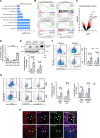The Peptidoglycan Recognition Protein 1 confers immune evasive properties on pancreatic cancer stem cells
- PMID: 38754953
- PMCID: PMC11347225
- DOI: 10.1136/gutjnl-2023-330995
The Peptidoglycan Recognition Protein 1 confers immune evasive properties on pancreatic cancer stem cells
Erratum in
-
Correction: The Peptidoglycan Recognition Protein 1 confers immune evasive properties on pancreatic cancer stem cells.Gut. 2024 Dec 10;74(1):e11. doi: 10.1136/gutjnl-2023-330995corr1. Gut. 2024. PMID: 39658261 No abstract available.
Abstract
Objective: Pancreatic ductal adenocarcinoma (PDAC) has limited therapeutic options, particularly with immune checkpoint inhibitors. Highly chemoresistant 'stem-like' cells, known as cancer stem cells (CSCs), are implicated in PDAC aggressiveness. Thus, comprehending how this subset of cells evades the immune system is crucial for advancing novel therapies.
Design: We used the KPC mouse model (LSL-KrasG12D/+; LSL-Trp53R172H/+; Pdx-1-Cre) and primary tumour cell lines to investigate putative CSC populations. Transcriptomic analyses were conducted to pinpoint new genes involved in immune evasion. Overexpressing and knockout cell lines were established with lentiviral vectors. Subsequent in vitro coculture assays, in vivo mouse and zebrafish tumorigenesis studies, and in silico database approaches were performed.
Results: Using the KPC mouse model, we functionally confirmed a population of cells marked by EpCAM, Sca-1 and CD133 as authentic CSCs and investigated their transcriptional profile. Immune evasion signatures/genes, notably the gene peptidoglycan recognition protein 1 (PGLYRP1), were significantly overexpressed in these CSCs. Modulating PGLYRP1 impacted CSC immune evasion, affecting their resistance to macrophage-mediated and T-cell-mediated killing and their tumourigenesis in immunocompetent mice. Mechanistically, tumour necrosis factor alpha (TNFα)-regulated PGLYRP1 expression interferes with the immune tumour microenvironment (TME) landscape, promoting myeloid cell-derived immunosuppression and activated T-cell death. Importantly, these findings were not only replicated in human models, but clinically, secreted PGLYRP1 levels were significantly elevated in patients with PDAC.
Conclusions: This study establishes PGLYRP1 as a novel CSC-associated marker crucial for immune evasion, particularly against macrophage phagocytosis and T-cell killing, presenting it as a promising target for PDAC immunotherapy.
Keywords: CANCER IMMUNOBIOLOGY; IMMUNE RESPONSE; PANCREATIC CANCER; STEM CELLS.
© Author(s) (or their employer(s)) 2024. Re-use permitted under CC BY. Published by BMJ.
Conflict of interest statement
Competing interests: None declared.
Figures








References
-
- Cancer.net . Pancreatic cancer: statistics. ASCO; 2022. Available: https://www.cancer.net/cancer-types/pancreatic-cancer/statistics#:~:text...
MeSH terms
Substances
LinkOut - more resources
Full Text Sources
Medical
Molecular Biology Databases
Research Materials
Miscellaneous
